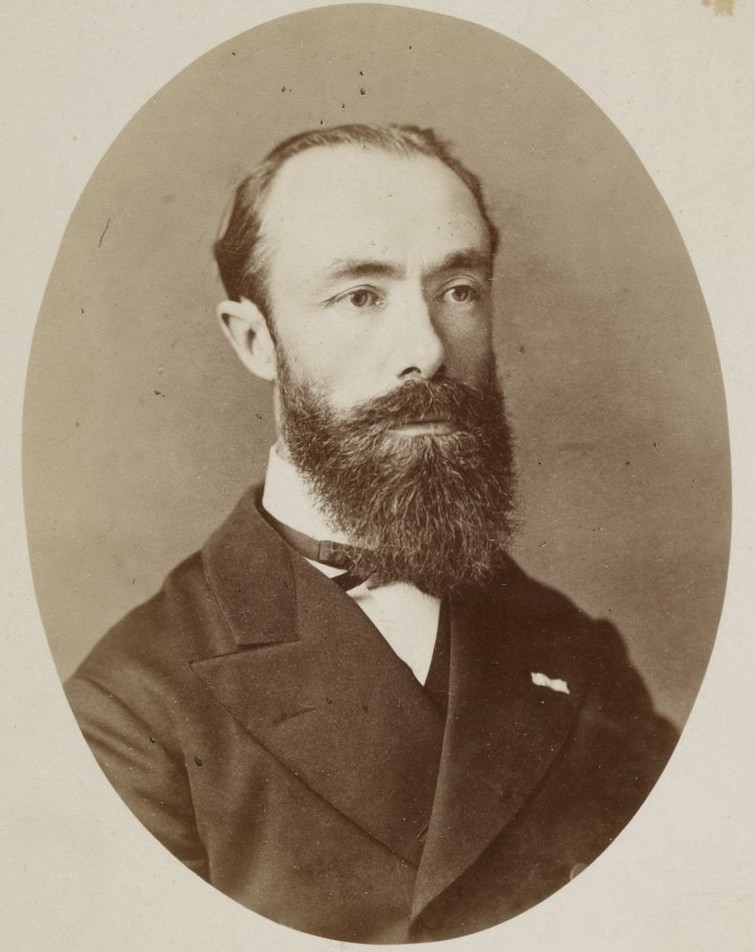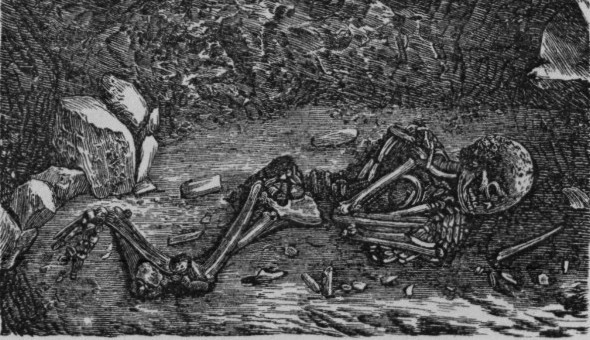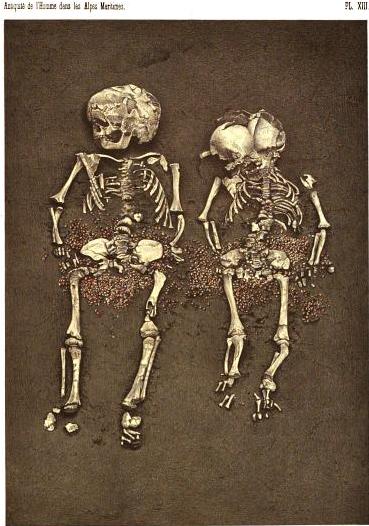Émile Rivière (1835-1922)
Matthew Goodrum

Émile-Valère Rivière de Précourt was born in Paris on 22 April 1835. His father was a physician and after attending the lycée Bonaparte Rivière also decided to study medicine. He was an intern at the asiles de convalescence (convalescent asylum) Vincennes, but illness interrupted his career. In 1868 he traveled to Cannes in the hope that this would improve his health. Rivière then traveled to Menton, a town on the French coast near the Italian border, in April 1869. There he visited the nearby caves of Baoussé-Roussé, just across the border in Italy in the commune of Grimaldi, with his friend Stanislas Bonfils, who had an interest in prehistory. Bonfils had opened a natural history museum in Menton in 1860 and he had collected fossils and artifacts from the Grimaldi caves near Menton since 1850. The construction of the railroad from Marseille to Genoa exposed numerous animal fossils, making this an excellent area to conduct paleontological research. Enamored with the region, Rivière decided to move to Menton in 1870 to pursue his new interest in prehistory.
After obtaining permission from the Italian government, Rivière conducted excavations in the nine caves at Baoussé-Roussé from 1870 to 1875. His excavations were systematic and he carefully recorded the stratigraphy of each cavern. On 26 March 1872 he unearthed a human skeleton covered in black hematite and red ochre along with an ornament made of shells and deer teeth as well as stone artifacts in a cave called Grotte du Cavillon. This remarkable find was followed, in February and June 1873 by his discovery of three human skeletons in the Grotte Bausse da Torre, which he first began excavating in 1871. These were also associated with stone artifacts and ornaments made of shells, as well as extinct Pleistocene animals such as cave bear, hyena, and rhinoceros. These discoveries were significant because few human fossils from the Paleolithic had been discovered at this time. When Rivière examined these skeletons and compared them with other Pleistocene human remains he concluded that the humans from Baoussé-Roussé were similar to the human skeletons found at Cro-Magnon. These human skeletons were eventually donated to the Muséum National d’Histoire Naturelle in Paris.

Rivière moved on to examine other caves at the site and in July 1875 he unearthed the skeletons of two children. These were later donated to the geological collections of the Institut Catholique de Paris. Rivière believed all these skeletons were from undisturbed deposits that belonged to the end of the Mousterian or the beginning of the Solutrean despite the fact that some artifacts were made of bone that some considered to be Magdalenian. He also argued that the positioning of the bodies and the objects found with them were evidence that they had been intentionally buried. However, several prominent French prehistorians, including Gabriel de Mortillet and René Verneau, believed the human skeletons found at Menton did not date from the Paleolithic but instead were more recent Neolithic burials.1

A later dispute over the geological age of a human skeleton found among Pleistocene animal fossils at Billancourt in the outskirts of Paris, which Rivière believed was an example of the intrusive burial of a much later human body in an older geologic deposit, prompted Rivière to seek the assistance of Adolphe Carnot, professor of chemistry at the École des Mines in Paris, in developing a chemical method to determine the relative ages of fossil bones. In 1892 Carnot measured the amount of fluorine present in human bones from Billancourt and compared them with the amount of fluorine present in the Pleistocene animal fossils found at the site. Since bone absorbs fluorine dissolved in ground water at a constant rate, bones of the same geologic age should contain about the same amount of fluorine while bones deposited at different times will contain different amounts, as long as they originate from the same locality. In a series of papers published between 1892 and 1893 Carnot and Rivière reported the results of their research using the fluorine dating method, which showed that the human remains found at Billancourt were in fact much younger than the animal fossils and therefore did not date from the Pleistocene.
Rivière later shifted his research to the Dordogne region, where previous French archaeologists had discovered numerous caves containing human remains and artifacts belonging to the Paleolithic period. He and the French archaeologist and geologist Gustave Chauvet were among the first to explore the Paleolithic site of La Micoque in 1895, which became the location of valuable excavations by other archaeologists during the early twentieth century. Rivière made an important contribution to the study of Paleolithic care art when he began to investigate the Grotte de la Mouthe, located near Eyzies de Tayac, in 1894. During his excavations of this cave he found Paleolithic flint artifacts, but in 1895 he noticed faintly visible figures of bison, ibex, stag, horse, and reindeer engraved on the walls, partially covered by stalagmite. This was not the first discovery of cave art. While excavating the Altamira cave located on his estate in Spain in 1879, Marcelino Sanz de Sautuola had discovered paintings of extinct Pleistocene animals on parts of the cave wall. Despite the fact that Juan Vilanova y Piera, professor of geology at the University of Madrid, believed these images to be authentic examples of Paleolithic art the majority of European prehistorians believed the paintings to be fraudulent. The subject of Paleolithic cave paintings and engravings was therefore quite controversial. Rivière announced his discovery to the president of the Académie des Sciences and read a paper on the subject there in 1896. By 1897 his excavations had produced extinct animal fossils along with stone tools, perforated shells, and an engraved limestone lamp. He traced the wall art and had it photographed by Charles Durand, which made them the first photographs taken of Paleolithic cave engravings. The animals depicted on the walls resembled the images on portable art that had been accepted as authentic Paleolithic art.
Rivière presented a paper outlining his discoveries on 3 June 1897 to the Société d’Anthropologie de Paris but was unable to convince Émile Cartailhac and Édouard Harlé, two French prehistorians who had inspected the cave paintings at Altamira and rejected them as forgeries. His claims generally received a great deal of skepticism but some archaeologists believed it was important to inspect the site before forming an opinion. Therefore, on 10 August 1896 a delegation of experts from the Société Historique et Archéologique du Périgord [Historical and Archaeological Society of Périgord] examined the engravings and concluded that they were in fact authentic. It was not until 14 August 1902 that members of the Association Française pour l’Avancement des Sciences [French Association for the Advancement of the Sciences] made an excursion to the site to officially examine it. Opinions about the authenticity of Paleolithic cave paintings and engravings changed as additional discoveries at other sites finally led Cartailhac and others to publically accept cave art in 1902. Meanwhile, Rivière continued to excavate various prehistoric sites. He excavated a Gallo-Roman necropolis on the Rue du Hameau in Paris in 1903. Then in 1905 he discovered what he considered to be a human skeleton dating from the Chellean-Mousterian period at the rock shelter at Moustier de Peyzac, in the Dordogne region of France.
Rivière’s career as a scientist was also developing at this time. He published De l’antiquité de l’homme dans les Alpes-Maritimes [On the Antiquity of Man in the Maritime Alps] in1887. This was an award winning book on the prehistory of that region based upon excavations of its caves, megalithic monuments, barrows, and dolmens. From 1880-1904 he was a writer for the journal Revue scientifique. He was hired to be the Deputy Laboratory Assistant at the Collège de France [at least from 1897] and was later promoted to Assistant Laboratory Director and eventually Laboratory Director in 1905. He was also active in French intellectual life. He became an early member of the Association des Journalistes Parisiens [Association of Parisian Journalists] in 1887. He was a member of the Association Française pour l’Avancement des Sciences. He was a member of the Société d’Anthropologie de Paris [Anthropology Society of Paris] and of the Société Française d’Archéologie [French Society of Archaeology], the leading anthropological and archaeological societies in France.
Rivière was also a member of several prominent historical societies:
Société archéologique et historique des IIIe, IVe, XIe et XIIe arrondissements de Paris
Société de l’histoire de Paris et de l’Île-de-France (member since 1879)
Société des amis des monuments parisiens (member from 1898 to1900)
Société historique d’Auteuil et de Passy
Société historique du VIe arrondissement de Paris
Société scientifique et littéraire de Cannes et arrondissement de Grasse
Rivière contributed to the promotion and institutionalization of prehistoric archaeology in France when he and the physician and prehistorian Paul Raymond proposed the idea of creating the Société Préhistorique de France (Prehistoric Society of France) in 1903. The Society was formally established in January 1904 with Rivière serving as its president during the first year of its existence. The Society was renamed the Société Préhistorique Française in 1911. Rivière served as president of the inaugural meeting of the Congrès Préhistorique de France [Prehistoric Congress of France] held in Périgueux in 1905, which was organized by the Société Préhistorique de France.
Rivière won numerous awards during his lifetime and was ten times a laureate of the Académie des Sciences. In addition to his prehistoric research he also published on the history of medicine. Rivière is credited with inventing the term spéléologie (speleology) in 1890, from the Greek spêlaion (cavern) and logos (science), to refer to the study of caves.
Émile Rivière died on 25 January 1922 in Paris.
Selected Bibliography
“Sur le squelette humain trouvé dans les cavernes des Baoussé-Roussé (Italie), dites grottes de Menton, le 26 Mars 1872,” Matériaux pour l’histoire primitive et naturelle de l’homme ser. 2, 7 (1872): 228-232.
“Note sur l’homme fossile des cavernes de Baoussé Roussé, en Italie, dites Grottes de Menton.” Congrès international d’anthropologie et d’archéologie préhistoriques Comptes rendus (1872): 164-175.
“Les fouilles des grottes de Baoussé-Roussé, dites grottes de Menton.” Bulletins de la Société d’Anthropologie de Paris 7 (1872): 584-589.
“Découverte d’un nouveau squelette humain de l’époque paléolithique dans les cavernes des Baoussé-Roussé (Italie), dites Grottes de Menton.” Comptes rendus hebdomadaires des séances de l’Académie des Sciences 76 (1873): 1027-1031.
“Sur trois nouveaux squelettes humains découverts dans les grottes de Menton et sur la disparition des silex taillés et leur remplacement par des instruments en grès et en calcaire.” Matériaux pour l’histoire primitive et naturelle de l’homme 9 (1874): 94-98.
“Détermination par l’analyse chimique de la contemporanéité ou de la
concontemporanéité des ossements humains et des ossements d’animaux trouvés dans un même gisement.” Association française pour l’avancement des sciences Comptes Rendus part 2 (1892): 378-382.
“Fossilisation et analyse chimique des os.” Bulletins de la Société d’Anthropologie de Paris ser. 4, 4, (1893): 309-315.
“La grotte de la Mouthe,” Bulletins de la Société d’Anthropologie de Paris 8 (1897): 302-329, 484-490
De l’antiquité de l’Homme dans les Alpes-Maritimes. Paris, J.B. Baillère, 1887.
Gustave Chauvet and Émile Rivière. “Gisement quaternaire de La Micoque.” Comptes rendus hebdomadaires des séances de l’Académie des Sciences 123 (1896): 401-403.
Gustave Chauvet and Émile Rivière. “Station quaternaire de La Micoque (Dordogne).” Association française pour l’avancement des sciences Comptes rendus part 2, (1897): 697-707.
“Le squelette humain chelléo-moustérien du Moustier-de-Peyzac (Dordogne).” Bulletin de la Société préhistorique de France 5 (1908): 441-442.
“Note sur l’ordre chronologique véritable des six premières découvertes de grottes à gravures et à peintures.” Bulletin de la Société préhistorique de France 6 (1909): 376-380.
Secondary Sources
“Obsèques de M. Emile Rivière.” Bulletin de la Société préhistorique de France 19 (1922): 50-52.
J. Bossavy, “M. Émile Rivière.” Bulletin de la Société préhistorique de France 19 (1922): 257-267.
L. Franchet. “Emile Rivière (1835-1922).” Revue scientifique (1922): 127-128.
Louis Capitan. “Émile Rivière.” Revue anthropologique (1922): 6-7.
Martha B. Kendall. “Rivière de Précourt, Émile-Valère.” In Dictionary of Scientific Biography. Charles Gillispie (ed.). Vol. 11, pp. 483-484. New York: Charles Scribner’s Sons, 1970.
Philippe Soulier, “Aux origines de la Société Préhistorique Française: la Société Préhistorique de France (1904-1910).” Bulletin de la Société préhistorique française, 90, (1993): 95-103.

